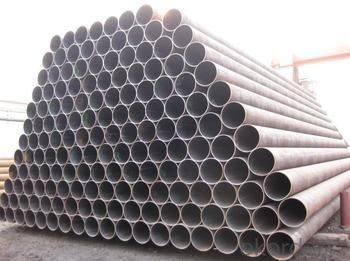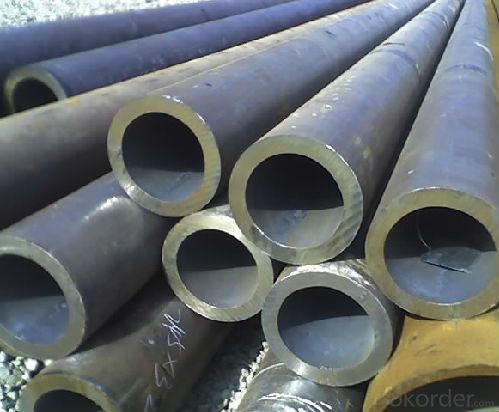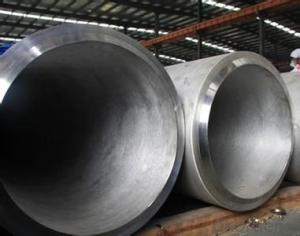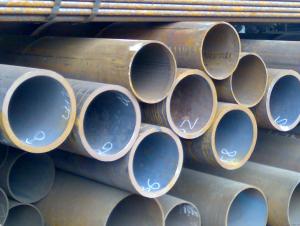API 5L Thick Wall Seamless Stainless Steel Tube
- Loading Port:
- Tianjin
- Payment Terms:
- TT or LC
- Min Order Qty:
- 25 m.t.
- Supply Capability:
- 10000 m.t./month
OKorder Service Pledge
OKorder Financial Service
You Might Also Like
We are company that have many years experience and professional manager team and engineer team and sales team, sure we will provide you high quality of pipe and professioanl service.
Seamless pipe possesses a hollow section and without seam around the strip steel. It is made with solid bar or steel ingot by perforating machine. As the facture process does not include any welding, seamless pipes are considered to be stronger and more durable. Generally speaking, seamless pipe has better pressure resistance and security than other classifications, and was usually more easily available than welded pipe.
2、Main Features of the Seamless Pipe:
• High working accuracy
• High strength
• Small inertia resistance
• Strong therming dissipine ability
• Good appearance
• Reasonble price
3、Seamless Pipe Specification:
Standard | GB, DIN, ASTM ASTM A106-2006, ASTM A53-2007 |
Grade | 10#-45#, 16Mn 10#, 20#, 45#, 16Mn |
Thickness | 8 - 33 mm |
Section Shape | Round |
Outer Diameter | 133 - 219 mm |
Place of Origin | Shandong, China (Mainland) |
Secondary Or Not | Non-secondary |
Application | Hydraulic Pipe |
Technique | Cold Drawn |
Certification | API |
Surface Treatment | factory state or painted black |
Special Pipe | API Pipe |
Alloy Or Not | Non-alloy |
Length | 5-12M |
Outer Diameter | 21.3-610mm |
Grade | 20#, 45#, Q345, API J55, API K55, API L80, API N80, API P110, A53B |
Standard | ASME, ASTM |
1) Material:20#(ASTM A 106/A53 GRB.API5LGRB,GB),45#,16Mn,10#.
2) Specification range: OD: 21.3-610mm, WT:6-70mm, length:6-12m or according to the requirement of clients.
3) Executive standards: GB, ASME API5L.ASTM A 106/A53,Despite of the above standards, we can also supply seamless steel pipe with standard of DIN, JIS, and so on, and also develop new products according to the requirements of our clients!
4) Surface: black lacquered, varnish coating or galvanized.
5) Ends: Beveled or square cut, plastic capped, painted.
6) Packing: bundles wrapped with strong steel strip, seaworthy packing.
4、Packaging & Delivery:
Packaging Details: | seaworthy package, bundles wrapped with strong steel strip |
Delivery Detail: | 15-30days after received 30%TT |
5、FAQ of Seamless Pipe:
①How is the quality of your products?
We have many years business experience in this area, and we have professional engineer and manager team and sure we can provide you high quality production and professional service.
②How about price?
Yes, we are factory and be able to give you lowest price below market one, and we have a policy that “ for saving time and absolutely honest business attitude, we quote as lowest as possible for any customer, and discount can be given according to quantity”,if you like bargain and factory price is not low enough as you think, just don’t waste your time.Please trust the quotation we would give you, it is professional one.
③Why should you chose us?
We can give you both.Additionally, we can also offer professional products inquiry, products knowledge train(for agents), smooth goods delivery, exellent customer solution proposals.Our service formula: good quality+good price+good service=customer’s trust
SGS test is available, customer inspection before shipping is welcome, third party inspection is no problem.
6、Seamless Pipe Images:


- Q:Are stainless steel pipes resistant to sulfide stress corrosion cracking?
- Yes, stainless steel pipes are generally resistant to sulfide stress corrosion cracking due to their high chromium content which forms a passive protective layer on the surface, preventing corrosion.
- Q:Can stainless steel pipes be insulated with ceramic?
- Ceramic can indeed be used to insulate stainless steel pipes. It is commonly utilized in industrial settings that involve high temperatures. Ceramic insulation offers exceptional heat resistance and thermal insulation properties, making it an excellent choice. It can withstand extreme temperatures and effectively reduces heat transfer. Various industries utilize ceramic insulation to insulate pipes, tanks, furnaces, and other equipment. When applied to stainless steel pipes, ceramic insulation helps maintain the fluid's temperature, preventing heat loss or gain. Additionally, it provides protection against corrosion and mechanical damage. In summary, ceramic insulation is a suitable option for insulating stainless steel pipes in a wide range of applications.
- Q:How about stainless steel 2520 and 316?
- 316 stainless steel by adding Mo element, the corrosion resistance, and high temperature strength has greatly improved, high temperature can reach 1200-1300 degrees, can be used in severe conditions. Uses: marine equipment, chemicals, dyes, paper, oxalic acid, fertilizer and other production equipment; photography, food industry, coastal facilities, ropes, CD poles, bolts, nuts.
- Q:Can stainless steel pipes be fabricated?
- Yes, stainless steel pipes can be fabricated.
- Q:What is the significance of the schedule in stainless steel pipes?
- The thickness of the pipe walls is what the schedule in stainless steel pipes refers to. It plays a crucial role in determining the pipe's strength, durability, and ability to handle pressure. The schedule is represented by a numerical value, such as Schedule 10, Schedule 40, or Schedule 80, which indicates the thickness of the pipe. The schedule's importance lies in its impact on the pipe's ability to withstand different conditions and applications. A higher schedule number means a thicker wall, resulting in increased strength and resistance to both internal and external pressures. This makes stainless steel pipes with a higher schedule suitable for applications that involve high pressure and high temperature, such as industrial processes, oil and gas pipelines, and chemical processing plants. Additionally, the schedule also affects the flow capacity of the pipe. Thicker-walled pipes have a smaller internal diameter, which reduces the flow rate compared to pipes with thinner walls. This factor is crucial when considering the fluid flow requirements in plumbing systems, HVAC installations, and other applications. The choice of the appropriate schedule for stainless steel pipes depends on specific project requirements, including pressure, temperature, and flow conditions. It is essential to select the correct schedule to ensure the pipe can safely and efficiently handle the intended application. To summarize, the significance of the schedule in stainless steel pipes lies in its influence on strength, pressure handling capabilities, and flow capacity. By understanding the schedule, engineers and professionals can make informed decisions when selecting and installing stainless steel pipes for various industrial, commercial, and residential applications.
- Q:Are stainless steel pipes suitable for chemical reactors?
- Yes, stainless steel pipes are suitable for chemical reactors. Stainless steel is known for its excellent corrosion resistance properties, making it an ideal choice for handling various chemicals and acids in a reactor system. Additionally, stainless steel pipes offer high strength, durability, and heat resistance, ensuring safe and efficient operation in chemical processes.
- Q:Can stainless steel pipes be used for gas or oil transportation?
- Yes, stainless steel pipes can be used for gas or oil transportation. Stainless steel is known for its high resistance to corrosion and can withstand high pressure and extreme temperatures, making it an ideal choice for transporting gas or oil safely and efficiently.
- Q:What is the difference between 410 and 316 stainless steel pipes?
- The chemical composition and intended applications set 410 and 316 stainless steel pipes apart. 410 stainless steel, a martensitic type, contains a higher carbon content ranging from 0.15% to 0.25% and a relatively lower chromium content between 11.5% and 13.5%. This composition grants 410 stainless steel pipes remarkable strength, hardness, and wear resistance. It is frequently employed in situations where corrosion resistance is not the primary concern, such as cutting tools, knives, and firearm components. On the flip side, 316 stainless steel is an austenitic variety with a higher chromium content, ranging from 16% to 18%, along with a significant nickel content between 10% and 14%. This composition provides 316 stainless steel pipes with exceptional corrosion resistance, particularly in environments containing chlorides or other corrosive agents. It finds widespread use in industries such as chemical processing, pharmaceuticals, food processing, and marine applications. To sum up, the primary distinction between 410 and 316 stainless steel pipes lies in their chemical composition and resulting properties. 410 stainless steel offers superior strength and hardness but has lower corrosion resistance compared to 316 stainless steel, which boasts high corrosion resistance but may have slightly reduced strength and hardness. The selection between the two depends on the specific requirements of the application, with 410 stainless steel being better suited for situations where strength and wear resistance are paramount, while 316 stainless steel is the preferred choice for applications demanding excellent corrosion resistance.
- Q:Can stainless steel pipes be used in the renewable energy industry?
- Yes, stainless steel pipes can be used in the renewable energy industry. Stainless steel is corrosion-resistant, durable, and able to withstand high temperatures and pressures, making it suitable for various applications in renewable energy systems such as solar thermal, geothermal, and biomass. It is commonly used for transporting fluids, gases, and steam in these systems, ensuring reliable and efficient energy production.
- Q:Are stainless steel pipes suitable for pharmaceutical laboratories?
- Stainless steel pipes are a suitable option for pharmaceutical laboratories. They are widely used in the pharmaceutical industry because of their exceptional resistance to corrosion, high strength, and durability. These pipes are also highly hygienic and easy to clean, making them perfect for pharmaceutical laboratories where cleanliness and sterility are crucial. Moreover, the smooth internal surfaces of stainless steel pipes prevent the buildup of bacteria, contaminants, or particles. Additionally, stainless steel is non-reactive and does not release any harmful substances, ensuring the quality and safety of pharmaceutical products. Overall, stainless steel pipes are a dependable choice for pharmaceutical laboratories as they fulfill the strict requirements for cleanliness, durability, and product safety.
1. Manufacturer Overview |
|
|---|---|
| Location | |
| Year Established | |
| Annual Output Value | |
| Main Markets | |
| Company Certifications | |
2. Manufacturer Certificates |
|
|---|---|
| a) Certification Name | |
| Range | |
| Reference | |
| Validity Period | |
3. Manufacturer Capability |
|
|---|---|
| a)Trade Capacity | |
| Nearest Port | |
| Export Percentage | |
| No.of Employees in Trade Department | |
| Language Spoken: | |
| b)Factory Information | |
| Factory Size: | |
| No. of Production Lines | |
| Contract Manufacturing | |
| Product Price Range | |
Send your message to us
API 5L Thick Wall Seamless Stainless Steel Tube
- Loading Port:
- Tianjin
- Payment Terms:
- TT or LC
- Min Order Qty:
- 25 m.t.
- Supply Capability:
- 10000 m.t./month
OKorder Service Pledge
OKorder Financial Service
Similar products
New products
Hot products
Hot Searches
Related keywords





























